
By Mayank Kumar / Sunday Guardian Live
NEW DELHI: The Rashtriya Swayamsevak Sangh (RSS), one of the world’s most discussed social organisations, is looking to achieve major targets by 2025 which will mark 100 years of its foundation. The organisation, which forms the backbone of the ruling Bharatiya Janata Party, wants to have one lakh shakhas (branches) by 2025 and will also bring out a book on Hinduism and nationalism which will in a way highlight the organisation’s comprehensive understanding of the much debated issue of contemporary India. It is interesting to note that the Sangh’s bête noire and former Indian National Congress (INC) president Rahul Gandhi had time and again in the recent past raised a debate on Hinduism versus Hindutva.
The organization, which was formed in 1925 in Nagpur by Keshav Baliram Hedgewar, has seen exponential growth in the last 10-12 years as people’s zeal to know and participate in the organisation has grown rapidly. Since 2010, the Sangh has added more than 22,000 shakhas (branches), which means a growth of almost 65%. As of now nearly 60,000 shakhas of the RSS are actively running in the country, of which 55% are run by college- and school-going students. To cater to the needs of different sections of the population, the organisation has brought in flexibility in recent times like Ratri Milan for students and Saptahik Milan (meet) for working professionals who have tight schedules. In this context, Manmohan Vaidya, joint general secretary of the organisation, had said, “We have seen particular interest shown by youths aged between 18 to 30 who want to join the RSS but are not aware of the procedure. From 2017 to 2022, every year 1.25 lakh youths have filled in details on our website.”
The grand plan to achieve one lakh shakhas (branches) by 2025 was also discussed in detail in this year’s Akhil Bharatiya Pratinidhi Sabha, the all-India meet of the RSS which was attended by 1,284 representatives in Ahmedabad. Office bearers from different offshoots or sister organisations including Bharatiya Mazdoor Sangh (BMS), Vishwa Hindu Parishad (VHP), Akhil Bharatiya Vidhyarthi Parishad (ABVP) were also in attendance. The BJP was represented by General Secretary (organisation) B.L. Santosh. During the lockdowns the physical activities of the RSS had slowed down a bit, but now the organisation has resumed almost 99% of its work.
Many critics of the organisation argue that this rapid growth has everything to do with its political affiliate the BJP coming to power, but office bearers and many independent analysts don’t buy that argument. “Between 2010 and 2014, the BJP was not in power, but on an average, we were able to open 1,600-2,000 new shakhas each year. It is unfair to say that as BJP is in power, the Sangh Parivar is growing, the Sangh has been active since 1925 in the most hostile environment,” said a senior RSS leader based in New Delhi. Analysts point out that the debate on Hindu nationalism and terror initiated by then Congress government in 2009 onwards, helped the organisation gain more visibility and acceptance.
Talking to The Sunday Guardian, Sumit Kumar, a social scientist who had written on the Sangh, said, “In the last 10 years, the organisation has grown rapidly. Critics are right to an extent that a favorable government is helping the RSS to reach remote areas and giving a conducive environment. But we must also give credit to the organisation that even before the BJP’s coming to power, it had deep roots across the country with more than 35,000 shakhas.”
This article first appeared on sundayguardianlive.com





